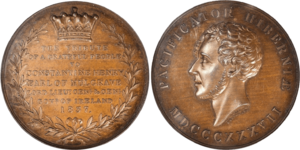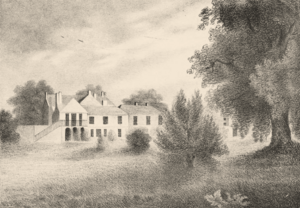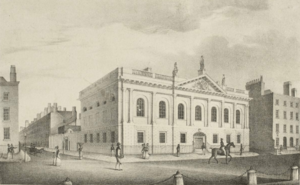Bernard Mulrenin facts for kids
Quick facts for kids
Bernard Mulrenin
|
|
|---|---|

Self-Portrait by Bernard Mulrenin
|
|
| Born | 1803 |
| Died | 22 March 1868 (aged 64–65) |
| Resting place | St. Andrew's Church, Westland Row, Dublin |
| Nationality | Irish |
| Known for | Painting (miniature) |
| Spouse(s) |
Mary Quill
(died 1844) |
| Elected | Royal Hibernian Academy |
| Signature | |
 |
|
Bernard Mulrenin (1803 – 22 March 1868) was an Irish painter. He was best known for his tiny, detailed miniature paintings.
He was part of the early Celtic Revival movement. This movement celebrated old Irish culture and art. Mulrenin was known for his leadership and for showing his art often at the Royal Hibernian Academy. He painted portraits of many important people. These included those involved in Irish Nationalism, which was a movement for Irish independence.
Contents
About Bernard Mulrenin
Mulrenin was born in County Sligo, Ireland. He learned how to draw and paint with help from his local community. He mostly focused on painting small portraits. To help make a living, Mulrenin also worked for the Ordnance Survey. This group was responsible for making detailed maps of Ireland.
In 1825, Mulrenin moved to Dublin. Within a year, he showed his paintings at the new Royal Hibernian Academy. An early friend and supporter in Dublin was the novelist Lady Morgan. She helped Mulrenin meet important people. These included politicians and other artists like Amelia Curran and Thomas Moore. In the 1830s, Mulrenin's painting business grew a lot. This happened after other famous miniature painters, John Comerford and Samuel Lover, were no longer working in Ireland.

Mulrenin received a special appointment from the Earl of Clarendon in 1848. He also had his first art show at the Royal Academy of Arts in 1851. Even with this success, he stayed loyal to the RHA. He showed over 400 of his works there during his lifetime.
However, times became tough in the 1850s. Events like the Great Famine meant people had less money. This made it hard for the academy to sell art. The RHA faced money problems. In 1856, Michael Angelo Hayes became the secretary. He, along with the president and treasurer, wanted to make big changes. Mulrenin and his friend Mulvany did not agree with these changes. This led to disagreements within the academy. The school even closed for a short time the next year.
In 1859, Mulrenin gave a speech to the Royal Dublin Society. He talked about how photography could help portrait painters. He believed photos could be a tool, not a replacement, for painting. He even said he found a way to put photo negatives onto marble and ivory. This would make them look like miniature paintings. In 1864, Mulrenin's portrait of Oscar Wilde's mother was shown at the RHA. He also helped in a legal case involving Oscar Wilde's mother.
Where to See His Art
You can find Bernard Mulrenin's works in several important art collections:
- National Gallery of Ireland
- National Library of Ireland
- National Portrait Gallery
- Victoria and Albert Museum
- British Museum
- Harry Ransom Center
Famous Portraits by Mulrenin
| Portrait | Subject | Date | Medium(s) | Institution | Profession | Notes | Ref. |
|---|---|---|---|---|---|---|---|
| George Ensor | c. 1820-1843 | lithograph | National Library of Ireland | author | |||
| John Hogan | charcoal | National Gallery of Ireland | sculptor | purchased: 1878 | |||
| Daniel O'Connell | 1836 | watercolour | National Portrait Gallery | politician | |||
| Charles O'Conor | watercolour | National Gallery of Ireland | historian | ||||
| Lord Paget | lithograph | National Gallery of Ireland | politician | presented: 1901;
uncertain attribution |
|||
| George Petrie | oil | National Gallery of Ireland | antiquarian | presented: 1884 | |||
| Marie Taglioni | 1834 | lithograph | Victoria and Albert Museum | ballerina | |||
| Jane Wilde | 1864 | watercolour | personal archives:
Merlin Holland |
poet |
Other People He Painted
Scientists and Scholars
While Mulrenin mostly painted real people from his time, he also found ideas in stories. For example, he painted characters like Shakespeare's King Lear. He also painted figures from Irish mythology, such as Fionn-ghuala, who was the daughter of the sea god Lir.











